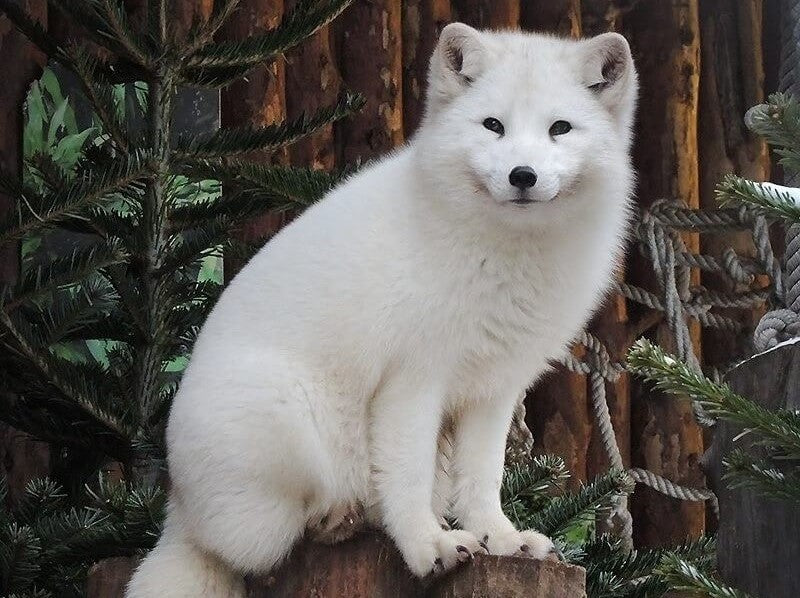Fylgja (plural Fylgjur) translated from Old Norse, means “someone that accompanies”. They are supernatural guardian spirits bound to a family line who are said to accompany a person throughout life.

Artic Fox Fylgja
It can also mean “afterbirth of a child” meaning that the afterbirth and the fylgja are connected. In some literature and sagas, the fylgjur can take the form of mice, dogs, foxes, cats, birds of prey or even carrion eaters, for in some instances, the fylgja can take on the form of the animal that shows itself when a baby is born.
A Fylgja could be perceived in two ways: The first is an animal form, which can be described as an extension of an aspect or characteristic of a particular family or person. They seem to embody a form of spirit guide for the one they choose, but also to work magical deeds for their protected. The second form is of a human, usually a woman, often representing an ancestral mother.
Quoting the translation from Maria Kvilhaug on the works of Professor Else Mundal, who wrote an academic paper on the topic, “Fylgjemotiva i norrøn litteratur” (Fylgjur Motifs in Norse Literature):
“The animal fylgja motif is sometimes blended with the húgr-motif. [Húgr (masculine singular) means “intent”, “desire”, “thought”, “soul”, “heart” and seems to have been a part of the human soul that could move outside of the body in animal shape]. Manna hugir [“the intents of men”] sometimes replace the term manna fylgjor [the “followers” of men] and usually then appear in the shape of wolves. Wolves, being associated with fierce passion and desire (or greed and hunger) are closely connected to the húgr. The other animals appear as manna fylgjor.”
(...)
“A woman fylgja (Hamingja) is a female supernatural entity who acts as a guardian spirit for the clan, and especially for the chief of the clan. They were also attached to individuals, but were immortal and appear to have been attached to particular lineages following a person from each generation. Mundal believes that they represent the spirits of ancestral mothers, a part of the ancestral mother worship we know existed among the Vikings.
Every human being may have one or more woman fylgja. Some are visible whereas others are invisible. Of the visible fylgjur a person has a limited number, of the invisibles a whole flock. The followers are carriers of an individual's or the clan’s fortune. The woman follower appears often in dreams but also in visions.”

A page from Njál's Saga - The Sögubók
Some authors, such Andy Orchard and Rudolf Simek note the parallel between the Fylgja and the Hamingja. The Hamingja may be transferred to a descendant or to a member of the family undergoing a perilous journey. The Hamingja grants wealth, success and power, and sometimes are viewed as a badge of honor.
It is widely thought that a Fylgja may abandon their chosen mortal if their behavior is poor, wicked, or would bring shame and disrepute to the family name.
Gabriel Turville-Petre, an English philologist who specialized in Old Norse studies, cites multiple instances where a volva’s (Norse sorcerer, usually female) fylgja is a fox, because the animal is cunning, sly or hiding something. He also quotes that oftentimes an enemy's fylgja is perceived as a wolf.
In the Icelandic Njál's Saga, some characters have the gift of foresight, enabling them to see their enemies’ Fylgjur, giving them a glimpse of the future. In The Story of Howard the Halt (Hárvarðar saga Ísfirðings), the character Atli has a dream about eighteen wolves running towards him with a female fox as their leader. As it turns out, the dream presages that Atli will be attacked by an army with a volva (sorcerer) at the front.

Volva, the Norse Witch
Fylgjur are also prominent in the Ljosvetninga Saga, and are used in a form of spiritual warfare. If a character had a more powerful Fylgja than the person crossing them, that individual would suffer some kind of misfortune. It seems that this is the result of their own Fylgja not being as strong or not being able to defend them from that of their enemy.
Some authors claim that the Fylgjur were the basis for another creature called “fetch” in Ireland, also known as the “which’s familiar” during the middle ages. This claim should be taken with a grain of salt, as it is impossible to be sure whether this was originally the same creature that appears in Icelandic literature or whether this is only a similar concept.
The concept of a spirit animal, totem or Fylgjur is widespread in many different cultures that were likely to have little to no interaction with each other. From North and South Americas, Siberia and even Australia, most shamanic traditions have some form of spirit animals or totems that help and guide individual persons or groups. It is a concept as old as time and shared all around the world.
Great Freyja, Goddess of Magic (among many other things) has two cats, Bygul and Trjegul who pull her chariot. Some authors claim that these cats are her Fylgjur
Sources:
Kvilhaug, Maria. The Seed of Yggdrasill: Deciphering the Hidden Messages in Old Norse Myths. ISBN-10 8792632289
Robert Kellog & Jane Smiley (Introduction). The Sagas of Icelanders. ISBN - 978-0141000039
Gylfason, Thorsteinn. Njál's Saga. ISBN-13 978-1853267857
Dasent, Sir George Webbe. The Story of Burnt Njal. From the Icelandic of the Njals Saga. ISBN-13 9781372045165
Simek, Rudolf. 2007 (1993). Translated by Angela Hall. Dictionary of Northern Mythology. D.S. Brewer. ISBN 0-85991-513-1
Orchard, Andy. 1997. Dictionary of Norse Myth and Legend. Cassell. ISBN 0-304-34520-2
Jesse Byock (2005) Snorri Sturluson, The Prose Edda. 1st. edition. London, England: Penguin Books Ltd. ISBN-13 978-0-140-44755-2
Faulkes, Anthony. Edda. Trans. 1982. Oxford University Press. ISBN-13: 9781389651922
Daniel McCoy. 2016. The Viking Spirit: An Introduction to Norse Mythology and Religion. 1st edition. CreateSpace Independent Publishing Platform. ISBN-13 978-1533393036














Comment (1)
Domovoi, Russian house spirit animals. Is there a connection?